| |
|
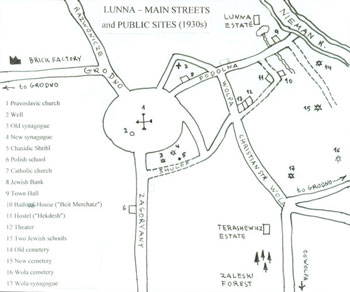 |
|
|
Scheme of Lunna - main streets and
public sites (1930s) |
|
The above map was constructed based on the memories of Eliezer
Eisenshmidt and Liza Welbel-Shwetz; both are former Lunna residents. A
map including a detailed location of residential buildings is in
preparation.
As in the 1900 map, the market-square was the center of Lunna
and was surrounded by residential buildings. There is a Pravoslavic
(Russian-Orthodox) church in the middle of the square. Next to the
church, there was a well from which water was pumped out into pails
and carried to the houses. Shops and small business were located at
the street level of houses around the square. Four streets lead from
the market-square to different directions: the Grodno (Grodzienska)
Street - led to the edge of town and through villages, to Grodno; the
Zagoryany Street - led to Zagoryany village, located 2 kilometers SSW
of Lunna; a side-street led to the Catholic Church and to Wolpa (Wolpianska)
Street which led to the "Goysher Gas", to Wola, and from there to
Wolpa, located 11 kilometers SE of Lunna; Podolna Street led to the
bridge over the Niemen River, and from there to the main road to
Skidel and Grodno.
The major streets were paved with pebbles (asphalt
was expensive) and side-streets were unpaved and muddy during the
rainy season and after the snow melted. Most of the town houses were
one level, built from wood (bricks were expensive) and with straw
roofs. Several houses were two story buildings and had nice verandas.
In July 1931 a big fire destroyed many of the town’s wooded buildings.
This large conflagration began, for unknown reasons, in a wooded
storage shed of a person named Mulia Kagan who resided in the middle
of Zagorynay Street. The flames spread with the wind and destroyed the
wooden houses and businesses in the market square. From there, the
fire spread to Grodno Street. After the fire, burnt wooden houses were
replaced with new houses made of brick, built on the same spot. On the
top of several new houses was inscribed the year 1931.
The Market-Square
Around the square stood the residences of Moshe-Yudel
Arkin - one of highly respected residents in town and a wealthy wood
merchant; Raphael Zlotoyabko - a Chasid who owned the largest grocery
store in town, on top of which was posted: "Iron, Harring and Other
Goods"; Zeev Berachowicz - the owner of a fabrics store and a partner
in the lumber mill located on the bank of the Niemen River; Yehoshua
Eliashberg - a partner in the lumber-mill and the owner of a liquor
store (his wife, Batya Eliashberg, had a small beverage bar in front
of the house); Yosef Eliashberg and Leib Goldin - workers in
ironmongery; Chaykel Friedman - the Mikvah manager; Eli Shalachman -
an owner of the "Piwiarnia" tavern at the front of a two-story house
his mother-in-law Basha Yogiel owned; Lubitz - an accountant of the
lumber-mill whose wife had a grocery store; Berengaus - a blacksmith;
Henie-Leah Arkin - the owner of a grocery store located in front of
her house; and Zvi Eisenshmidt - a merchant, who bought the new house
built after the big fire, his wife Frida was a violin teacher.
Among
the houses destroyed by the fire were the residences of Moshe-Yudel
Arkin, Raphael Zlototabko, Zeev Berachowicz, Leib Goldin, Lubitz and
others. The house of Yehoshua Eliashberg was built of bricks and
therefore was not destroyed by the fire, but there was damage to the
contents of the house. Yitzchak Eliashberg’s high school diploma, for
instance, was destroyed in the fire. Pictured below is a letter dated
December 15, 1931, from Gimnazum Tarbut in Grodno stating that Mr.
Eliashberg’s high school certificate was burnt in the 1931 fire.
Photos of Residences Around the Market-Square
|
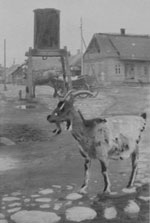 |
 |
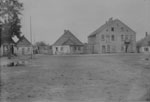 |
|
|
A goat in the marketplace near a water tank (1920s)
Source: The Yivo Institute for Jewish Research
|
|
|
Three goats on and by a stone wall near the
marketplace. A schoolboy with books under his arms (left) (1920s)
Source: The Yivo Institute for Jewish Research
|
|
|
Moshe-Yudel Arkin's home (right, two-story with balcony)
(1920s-1930s)
Source: The Yivo Institute for Jewish Studies
|
|
|
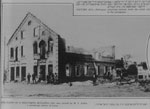 |
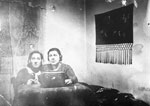 |
 |
|
|
Moshe-Yudel Arkin's house after the big fire (1931)
Source: The Yivo Institute for Jewish Studies |
|
|
Interior of Zlotoyabko residence
(ca. 1933).
Sarah Zlotoyabko (right), Liza Arkin (left). From the collection of
Libe Friedman-Ahuva Glick |
|
|
Location of Zlotoyabko residence (1958)
From the collection of Aba (Margulis) Margalit
|
|
|
 |
-s.jpg) |
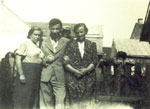 |
|
|
At the Berachowicz residence's courtyard
(ca. 1922).
From the collection of Miriam Welbel-Rutenberg |
|
|
Location of Berachowicz residence (1958)
From the
collection of Aba (Margulis) Margalit |
|
|
In front of Yehoshua Eliashberg's residence (1937).
From the collection of Yitzchak Eliashberg |
|
|
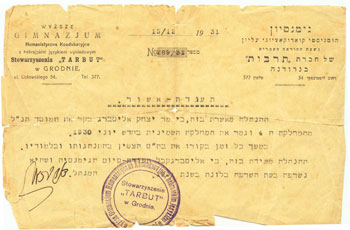 |
|
|
A letter from Gimnazum "Tarbut" (Culture) in Grodno,
dated December 15, 1931,
stating that Itzchak Eliashberg’s high school certificate was burnt
in the 1931 fire. From the collection of Itzchak Eliashberg |
|
|
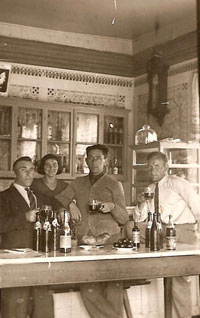 |
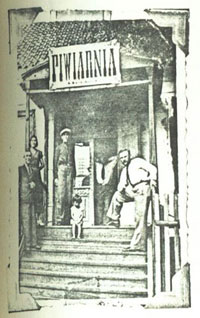 |
|
|
Interior of "Piwiarnia" tavern (ca. 1933)
Eli Shalachman, the owner (first from the left), at the interior of
the tavern. From the collection of Eli Shalachman
|
|
|
Exterior of the "Piwiarnia" tavern (ca. 1933)
From the collection of Eli Shalachman |
|
|
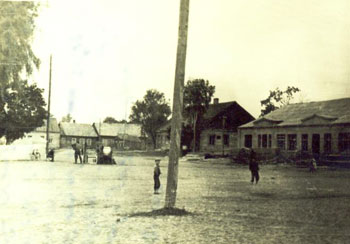 |
|
|
Location of the Jewish residences and
small shops (1958)
From the collection of Aba (Margulis) Margalit |
|
Grodno (Grodzienska) Street
Along the street stood the residences of Mordechai Kosovsky - a Chasid and a grain-trader, after his death, his
son Yosel Kosovsky moved in the house; Moshe Kosovsky – Mordechai's
brother, the founder of the "Hekdesh"; Berl Becker - an owner of a
restaurant; Zeev (Velvel) Kuperfening - an owner of a grocery store;
Moshe Feinzilber - a grain merchant; Shabtai Yanovsky - a painter,
Zalman Shneur - a blacksmith; Yaakov Welbel - a grain trader and one
of the Jewish leaders community (in the garden around his house were
many fruit-trees); and Chaya Roskin - a grocery owner.
There were
several non-Jews who resided in Grodno Street including a Polish
engineer who constructed the old bridge over the Niemen River. In the
forest, at the end of Grodno Street, after the brick factories, stood
the residence of a Polish physician named Raznetowski (who used to
also medicate for free poor Jews). Among the houses destroyed by the
fire and replaced with new buildings, were the residences of Zeev
Kuperfenig, Mordechai Kosovsky, Zalman Sheneir, Shabtai Yanovsky and
Berl Becker. The house of Moshe Kosovsky was built of bricks and
therefore was not destroyed by the fire, but there was damage to the
contents of the house. Moshe Kosovsky was supported by his sons who
had previously emigrated to the United States (his sons including
Motel, Abraham and Avigdor changed their family name to Kosow).
Photos of Residences in Grodno Street
|
 |
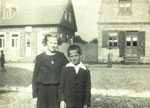 |
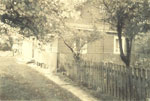 |
|
|
The old house of Mordechai Kosovsky (ca.
1929)
From the collection of Yitzchak Eliashberg |
|
|
In front of Yosel Kosovsky's residence (1935). Neuta and
Lolek Kosovsky (Yosel's
children). From the collection of Yitzchak Eliashberg |
|
|
Residence of Yaakov Welbel (1920s).
From the collection of Miriam Welbel-Rutenberg |
|
|
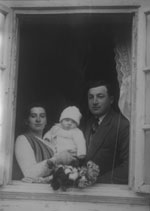 |
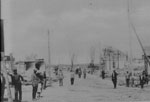 |
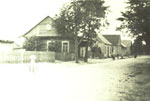 |
|
|
Residence of Berl Becker and
his family (1930s).
From the collection of Berl Becker |
|
|
A view of Grodno Street after
the big fire (1931)
Source: The Yivo Institute for Jewish Studies |
|
|
General view of Grodno Street (1958)
From the collection of
Aba (Margulis) Margalit |
|
Zagoryany Street
The 1931 big fire began at in a wood storage shed of Munia Kagan who resided in the middle of Zagorynay Street. The house
of Aaron Kosovsky - an owner of hardware store, was located on
Zagorynay Street (close to the market square). His wooded house was
burnt in 1931 and was replaced with a new house made of brick, built
on the same spot. After his death, the house was confiscated by the
head of the Polish police. Pictured below is a photo of Aaron
Kosovsky's house taken in 2006. Notice the inscription of 1931 and the
sign of Magen David on top of the building (this is the only building
in town that has an inscription of Magen David.) Other residences
along Zagorynay Street included the residence of Shneur (Zalman)
Friedman - an owner of dye-shop; and the two story residence of Elazar
Kagan - an owner of a cloths shop. The buildings of the "Kupat Gmilut
Chesed" and the Polish School were located on this street.
Photos of Residences in Zagorynay Street
|
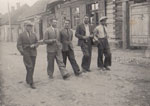 |
-s.jpg) |
-s.jpg) |
|
|
Five friends walking in
Zagorynay Street (1930s)
From the collection of Saul Rotberg |
|
|
General view of Zagoryany Street; "Kupat Gmilut Chesed"
was located in the two-story building (1958)
From the collection of Aba (Margulis) Margalit |
|
|
Location of the building of the Polish
Governmental School (1958).
From the collection
of Aba (Margulis) Margalit |
|
|
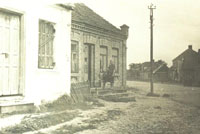 |
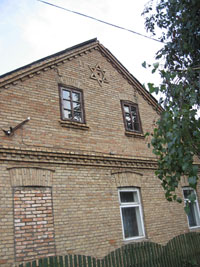 |
|
|
Location of the residences (facing the market-square) of Aaron
Kosovsky
(right) and Yehoshua Eliashberg (left) (1958)
From the collection of Aba (Margulis) Margalit |
|
|
Location of the residence of Aaron Kosovsky
(the side
facing Zagorynay Street). Inscription
of the year 1931 and a sign of Magen David
are on top of the building (2006).
From the collection of
Ruth (Eliashberg) Marcus |
|
Podolna Street
Along the street stood residences of Mordechai Yevnin -
the founder and one of the partners of a mill, his house was built in
1913, the left side quarter was occupied the Fire Fighters Wind
Orchestra; Yehoshua (Eshel) Win - one of the mill partners, the house
was built in 1910, the first level was occupied the Post Office (at
the back, in the garden, were beehives); Leib Reizner - one of the
lumber mill partners located at the bank of the Niemen River (had a
large vegetable garden); Yaakov Abin - a wood merchant, and his wife
Debora, who owned a fabrics shop; Tudel Kaplan - an owner of a
drugstore; Yaakov Maizel- a fabrics merchant, Chana Rochkin- an owner
of a bakery and a restaurant; and Zalutski - a licensed wood
inspector. The Jewish National Bank ("Bank Ludowski Zydowski") and the
pharmacy, owned by a non-Jew, were located on the street close to the
Market Square. The municipality building and a nearby Detention House
were located on the street close to the Niemen River. The Lunnyanka, a
small brook, ran into the Niemen River and a small bridge was located on
Podolna Street.
Photos of Podolna Street
|
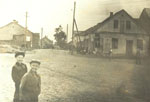 |
 |
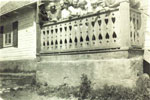 |
|
|
General view of Podolna Street; on the right is Chana
Rochkin's residence (1958) From the collection of Aba (Margulis)
Margalit |
|
|
The two-story Win's residence (1958)
From the collection of
Aba (Margulis) Margalit |
|
|
The balcony of Reizner's residence (1930).
Yehoshua (Eshel) and Pesia Win, and the grandchildren
From the
collection of Yitzchak (Aizik) Win |
|
|
 |
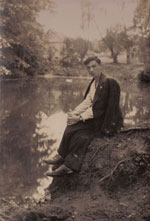 |
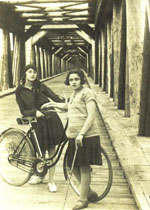 |
|
|
In front of the Reizner's
residence (1930)
From
the collection of Yitzchak
(Aizik) Win |
|
|
Yitzchak Eliashberg sits near the Lunnyanka brook
(ca.
1927).
From the collection of
Yitzchak Eliashberg |
|
|
The bridge over the Niemen River at the
edge of Podolna Street (1925)
From the collection of Miriam Welbel-Rutenberg |
|
|

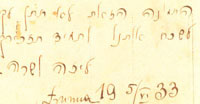 |
|
Sarah Zlotoyabko (left) and Liza Arkin (right) at the bank of the
Niemem River (1933). |
|
Dedication to Libe Friedman-Ahuva Glick
(1933) |
Wolpa (Wolpianska) Street
Along the street stood the residences of Yehoshua Eisenshmidt - the owner of carbonated water and lemonade
manufactory; Abraham Yedwab - one of the mill partners and an owner of
a grocery shop; Moshe-Nochum Welbel - producer of diary products (he
closed his dairy sometime between 1930 and 1935) and later the owner
of a mill; Yosel Welbel - a butcher (knew how to de-vain certain
portions of the cow to make it kosher) whose wife functioned as a
supplier of meat and other products for the deputy to the district
Minister of Finance who resided in Cherlona; Murawski - an owner of
roof constructing business; Aizik Sendler - a shoemaker; and Basha
Becker - an owner of a tea room. The two elementary schools occupied
the same building on Wolpa Street, the "Yiddish Folk Shul", in the
front and "Tora Ve'daat", at the back.
Photos of Wolpa Street
|
 |
 |
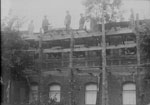 |
|
|
View of Wolpa Street at the intersection with Podolna
Street (1958)
From the
collection of Aba (Margulis) Margalit |
|
|
The location of the residences
of Yedwab (right) and Basha
Becker (1958) From the collection
of Aba (Margulis) Margalit |
|
|
Construction workers on the roof of the Yiddish School
(1927)
Source: The YIVO Institute for Jewish Studies |
|
Other Side-Streets
(i) A small unpaved side-street led from "Torah
Ve'daat" School in Wolpa Street to Podolna Street. The Theater, the "Hekdesh",
the bathhouse and the Mikvah were located on this lane. The residence
of Berl "der Furman" was close to the bathhouse. (ii) The "Shulof" lane
led from Wolpa Street to the two synagogues of the "Mitnagdim" and the
Stolin-Karlin Chasidim’s Shtibl close to the market-square. The
residence of Rabbi Tuvia Rotberg was close to the synagogue. The fire
fighter station, a wooden house with carriages loaded with water
barrels in the front, was close by. (iii) On another unpaved side lane
which led from Wolpa Street to Zagorynay Street stood the residences
of Shalom and Pesia Margulis who operated a coffee house in Podolna
Street; Gerszon Gisser - a butcher; Shimon Alperstein- a "Shochet" and
an owner of a lemonade manufactory; Yosel Werebeychik- an owner of a
bakery; Tuvia "der Stoler"- a carpenter; and Efron- a skilled worker.
Photos of Side-Streets
|
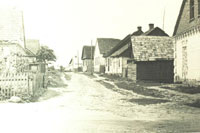 |
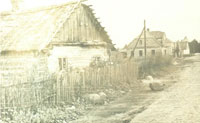 |
|
|
Unpaved side-street close to Wolpa
Street (1958)
From the collection of Aba
(Margulis) Margalit
|
|
|
Unpaved side-street near the Zagoryany Street (1958)
From the collection of
Aba (Margulis) Margalit |
|
|
 |
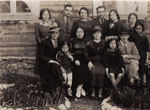 |
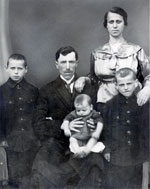 |
|
|
Rabbi Tuvia Rotberg inside
his house (1930s)
From the collection of Saul Rotberg |
|
|
Rabbi Tuvia Rotberg's family
(ca. 1933)
From the collection of Saul Rotberg |
|
|
The Gisser family
(ca. 1922-1925)
From the collection of Gerszon Gisser |
|
Wola and Zaleski Forest
The most prominent building in Wola was the synagogue, an unaesthetic
looking building, but was very beautiful inside. Many houses in Wola were
old and in poor condition. Yaakov Margulis, who visited Lunna in 1958,
indicated that the old houses were destroyed and new buildings were
built. The residential buildings included the houses of Aron Friedman
- a clerk; Berl Goland - a wood merchant; Slomianski - an owner of a
grocery; Fishel Levin - a butcher; Galinski - an owner and a partner
of a mill; Yaakov Klachkowsi - a teacher; Pluskalowski - a wood
merchant; Yankelewicz - a tailor; Pintelewski - an operator of
commercial ferry line on the Niemen river; Repanski - three brothers
who resided at the edge of Wola close to Zaleski village, Nachman
Replanski - a shoe-peg maker and his brother Eli- a tailor; Halpern -
an operator of a small boat service on the Niemen River.
The Zaleski
forest close to Wola and the Niemen River attracted summer vacationers
and Lunna’s youth. Note that the name "Zaleski" comes from two Russian
words "za" meaning "behind" and "lyes" meaning "forest". Apparently,
Zaleski is a family name. It could be that the forest and the village
Zaleskoe nearby were probably named after an old landlord or nobleman.
Photos of Wola and Zaleski Forest
|
 |
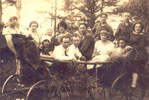 |
 |
|
|
View of Wola (1958)
From the collection of
Aba (Margulis) Margalit |
|
|
Lunna youth at Zalesli Forest
(ca. 1925)
From the collection of Etel Eliashberg-Prener |
|
|
Lunna youth at Zaleski Forest (ca. 1928)
From the collection of Miriam Welbel-Rutenberg
|
|
|
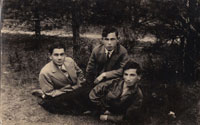 |
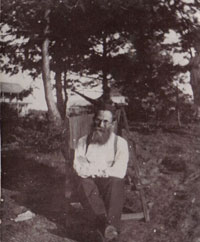 |
|
|
Three friends at Zaleski Forest (ca. 1929)
From the collection of Saul Rotberg |
|
|
Rabbi Rotberg at Zaleski Forest (1930s)
From the
collection of Saul Rotberg |
|
|
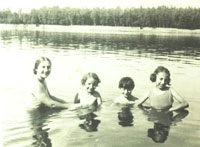 |
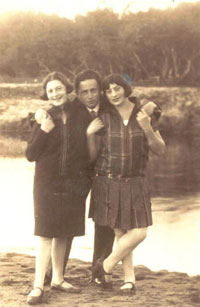 |
|
|
The Reizner sisters, bathing in the
Niemen River in Zaleski (1937)
From
the collection of Yitzchak
(Aizik) Win |
|
|
Near the stream (ca. 1927)
From the
collection of Etel Eliashberg-Prener
|
|
Estates in Lunna
There were two large estates near Lunna owned by wealthy Polish
noblemen. One estate was located close to the Niemen River at the edge
of Podolna Street. The owners of the estate hired Jews to manage the
small timber business on the estate. The other estate, near the
Zaleski forest, was owned by Edward Tarasowicz, a Polish prince.
|
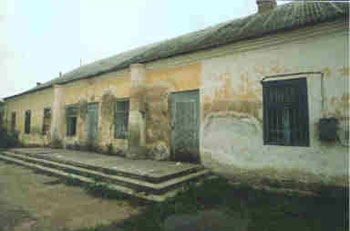 |
|
|
The location of the mansion of a
Polish nobleman in Lunna
(photo taken by Sandy Eisen, 2000) |
|
This site is hosted at no cost by JewishGen, Inc., the Home of Jewish
Genealogy. If you have been aided in your research by this site and
wish to further our mission of preserving our history for future
generations, your
JewishGen-erosity is greatly appreciated.
|
Compiled by
Ruth Marcus & Aliza Yonovsky Created
May 2007
Updated by rLb, March 2020
Copyright © 2007 Ruth Marcus
All the photos are presented
by courtesy of the families and are not allowed to be reproduced
without their permission. |
|
|